
Minimalism is key for fans of fastpacking and ultralight backpacking, but most of us will still find ourselves heavily laden once in a while. If you're carrying heavy winter gear, some climbing equipment, or several days' worth of food between distant resupply points, then saving a bit of weight on your rucksack at the expense of support may be a bit of a false economy, and you might decide you're better off with a solid load carrier. That fairly describes the Katmai (men's) and Kalmia (women's) packs from US brand Gregory. Robust mid-sized trekking packs with a host of features, they make up for their pretty hefty weight with high levels of support and comfort.
The Katmai comes in 55L or 65L sizes, while the Kalmia is available in 50L or 60L versions - prices range from £215 - £235. I have been using the Katmai 65. Though winter isn't really prime backpacking season, and the weather in recent months has made that even less appealing than normal, I've managed to use it on a couple of high-level overnight trips. With rough terrain and full winter loads, both myself and the pack have had some good workouts, so while my use to date hasn't been long it has certainly been rigorous enough to put the design through its paces.
Weight and build quality
On my scales the Katmai 65 is 2.2kg, which is just over Gregory's stated weight (the Katmai 55 isn't much lighter). You could easily pick up something simpler at this capacity that weighed half as much, but on the other hand heavier and more ponderous alternatives are also available. While it's no lightweight, I don't actually think that the Katmai 65 is unreasonably heavy for the nature of pack you're getting in terms of padding, structure, features and build quality. The fabrics and components all feel tough, and the workmanship is excellent, so this pack ought to prove a reliable companion for many years.
Capacity
I chose the larger version of the Katmai on the basis that a chunky load-carrier might as well have the capacity to hold a lot of gear. For a simple overnight trip the 55 (or women's 50) litre alternative would be more suitable, but for longer journeys, particularly if you're laden with several days' worth of food, something around 65 litres would make packing a lot easier. I have not found the 65 oversized on the shorter walks I've done with it to date, since some excess capacity can be fairly effectively compressed down. If you strap extra-bulky items such as a tent or a rollmat to the outside of the Katmai you can end up carrying really quite a lot with it. Its robust frame and supportive, well-padded back system are rated to a respectable max load of 20.4kg. This ought to be enough for most uses, and I wouldn't go out of my way to carry more.

Materials
While it can't be called light the Katmai seems robust for its weight, and while this hasn't been a long-term test I do think you'd have to be going some to do it significant damage. The main body of the pack uses 210D high density Nylon, which has a funky ripstop pattern and feels like a good balance of lightness and toughness; on the base, and parts of the upper pack that seem likely to take more wear and tear, Gregory have used a heavier-weight 420D Nylon. Both feature a high percentage of recycled material (40% and 45% respectively), while the weather resistance is boosted by a PFC-free DWR.
Have you ever suffered a smelly sack? I'm not sure it's something I've noticed enough to worry about in the past, but it's worth mentioning that the mesh fabric of the back panel is Polygiene-treated, to inhibit the growth of bacteria and thus stay less whiffy.
Fit and comfort
All models in the Katmai/Kalmia family are offered in two overlapping sizes: the Kalmia in XS/S (back length 35.6-43.2cm) or S/M (40.6-50.8cm); and the Katmai in S/M (38.1-48.3cm) or M/L (45.7-55.9cm) - if the metric dimensions look fiddly, it's because Gregory primarily work in inches. At 1.83m tall, and with a reasonably long trunk, I am towards but not at the upper end of the M/L size. Back length is easily adjusted via a big velcro tab so most users, except perhaps the very short or tall, should be able to get an optimum fit with the belt centred on the hips.
For structure, a steel alloy tubing frame wraps around the perimeter of the back. This has a bit of flex, so it doesn't feel like you're strapped to a board, but still provides plenty of support when heavily laden. Attached to the frame is the 'Freefloat 360' back system, one of the defining features of this pack, and the reason it's so comfortable when heavily loaded.
What's the 'freefloating' bit? Well with only a stretchy, perforated fabric panel in contact with your back, and an air gap between this and the main body of the pack, the ventilation is fantastic. While some suspended back panel designs have the disadvantage of shifting the pack's centre of gravity backwards away from the wearer, I don't find this to be a problem with the Katmai, which has a stable and well-balanced feel.
I presume, meanwhile, that '360' refers to the flexibility of the harness. Though you don't get 360-degree rotation, there's certainly a lot of movement built into the back system, with shoulder straps that each pivot independently at the top, and a stretchy, flexible interface between the hipbelt and the frame. These work together to give you a pack that feels like it's moving with you, rather than inhibiting your movement.
Very effectively transferring strain from the shoulders down onto your lower body and legs, the pre-curved fins of the belt hug closely onto the hips, with the added advantage of adjustable-length padding to fit users of a wide range of girths. The sculpted shoulder straps allow plenty of arm movement, and feature a sliding sternum clip, which you can easily move to the preferred height. For comfort and support the shoulder straps and the fins of the hip belt are densely cushioned, but the padding is so perforated that it remains exceptionally breathable (to test this, you can literally breathe through it).
With its combination of support, flex, breathability, adjustability, and comfort, the back system is one of the most effective I can remember using on a trekking pack.
Features
I tend to favour simplicity in a pack, but while there's a lot (or rather, a little) to be said for minimalism, the maximalist alternative has its advantages too. The Katmai/Kalmia is hardly under-endowed with bells and whistles, and if you like a rucksack with a lot going on then this could be for you. While every add-on has a logic, to my mind the overall effect can feel a bit cluttered, and one or two of the features are superfluous.
This is a conventional top-loader, with a floating lid that can be raised to accommodate an oversized load, or unthreaded and removed to leave you with a drawstring and top compression strap closure. For loose nicknacks you want to keep accessible, such as glasses, hat, and map, the lid features two external zipped pockets - one that's usefully deep, with a nice wide-opening zip, and another that I'd consider too small to bother with. Underneath is the usual zipped security pocket with the essential (but sometimes overlooked) key clip.

Entry can be made to the bottom of the pack via a low zip, with a removable divider inside to give you a separate lower compartment. This is a good place to keep sleeping gear, and it's nice to access it without having to remove everything else first; it would also be handy to keep a wet tent separate from the rest of your stuff. While I'd agree on the need for a bottom zip in a pack of this size, I'm less sold on the utility of additional side entries, since extra openings introduce weight and complexity, more potential points of zip failure, routes for rain to get in, and ways for gear to fall out and get lost. For me, no small gains in convenience stack up against all that. But if you disagree (a lot of pack users will), then Gregory is clearly in your camp here, providing a massive zipped side flap. With lots of external zips, none of them water resistant, the Katmai will inevitably leak in heavy rain; you'll need to protect your gear with dry bags (I did warn you...).
There's also a very large but slightly curious zipped pocket on the front of the pack, thin like a laptop sleeve, and featuring a mesh subdivider to keep things organised. But what things? Other than a map, or stuff like cutlery, I can't imagine what I might use this for, and it seems unnecessary. Better, for me, is the big, robust stretchy mesh pocket that also sits over the front of the bag. This is deep enough to securely hold a pair of folded trekking poles, a compact camera tripod, or a jacket that you might want to put on without having to open the pack. A smaller stretch sleeve is provided on one side, while on the other is a nifty fold-out bottle holder that I've only lately discovered and can certainly see myself using in preference to a water bladder, which the design of course also accommodates.
Long enough to be genuinely useful for attaching bulky rollmats and the like, the twin side compression straps fasten with a clip for convenience, and also do a good job of scrunching down an under-full pack. An additional pair of straps on the base of the pack gives you an alternative place to attach things cross-wise.
You get a large zipped pocket on each side of the hip belt, which I find ideal for thin gloves and snacks. There are also a couple of nice simple axe/pole attachment points, a loop on one shoulder to slip in the arms of a pair of sunglasses, a whistle on the chest buckle, and a hydration sleeve. I did say this was no minimalist.
Ethics and environment
As well as the recycled content, PFC-free DWR, and Bluesign approval for the Polygiene treatment, Gregory have included a graphic on their website quantifying various environmental impacts of the production of the Katmai 55 (which I'd assume also apply, only fractionally more so, to the Katmai 65):
Summary
We've established that the Katmai and Kalmia are no lightweights, but for the average user who's not overly concerned about saving every last gram the relative weight would be more than offset by the comfort and support on offer. Though some of the features seem a bit excessive and fiddly, it would be worth buying for the brilliant back system alone. Carrying a heavy pack is never exactly a pleasure, but with the Katmai it comes close.
Gregory say:
The Katmai 65 is large enough to accommodate the necessities while dynamic flex panels move with your body, delivering unprecedented comfort.












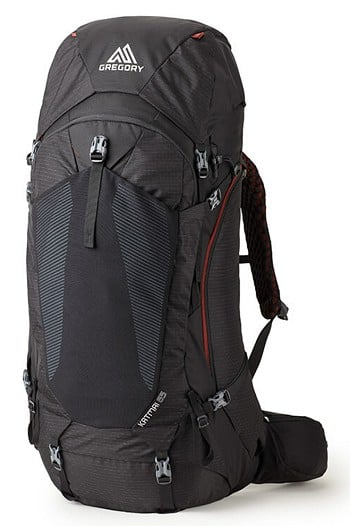
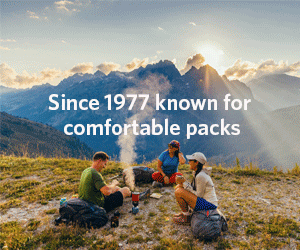



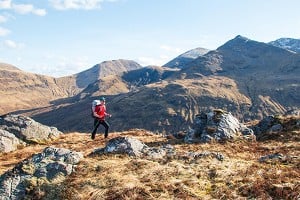
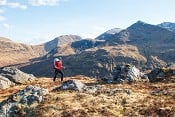
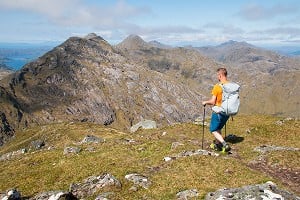
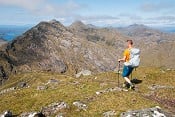













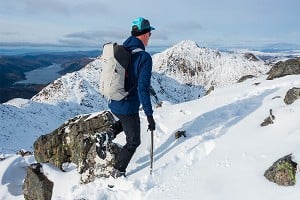

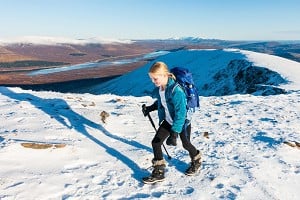

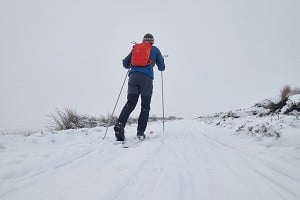
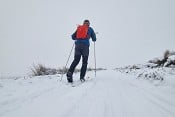
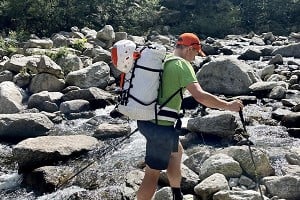

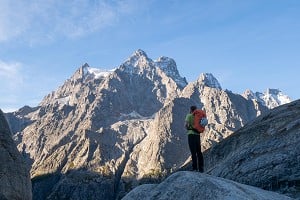
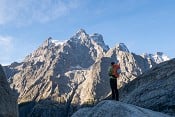
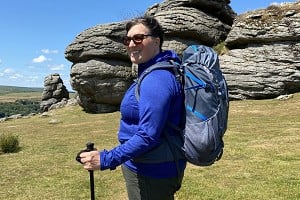
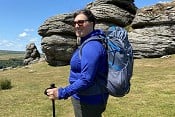


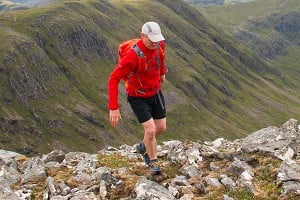
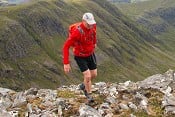
Comments
Thanks Dan
I picked up a Gregory Paragon 58 last year, which I've used a few times now and is overall similar. By far the most comfortable pack I've carried, and some of the little features are really good, as is the build quality as you say.
It recently carried about 30kg into Lochivaon bothy, well over its 23kg "max carry weight", with no problems other than my knees! The floating lid is well designed and allowed me to strap a 25 litre dry bag on top of the pack to extend its capacity for whisky and coal. The various attachment points also made strapping a guitar to the back easy, I'm sure something the designers included in their planning.